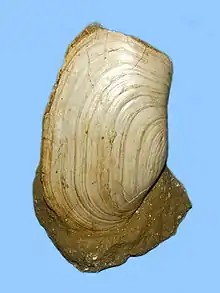| Castle Hayne Limestone | |
|---|---|
| Stratigraphic range: Eocene | |
| Type | Formation |
| Sub-units | New Hanover Member, Comfort Member, Spring Garden Member |
| Lithology | |
| Primary | limestone |
| Other | marl |
| Location | |
| Region | |
| Country | |
| Type section | |
| Named for | Castle Hayne, North Carolina |
The Castle Hayne Limestone (also called the Castle Hayne Formation) is a geologic formation in North Carolina. It consists of cobble to pebble sized clasts, usually rounded, coated with phosphate and glauconite in a limestone matrix. The Castle Hayne Limestone is known for containing fossils dating back to the Paleogene period. It preserves many of North Carolina's renowned Eocene fossils. It is named after the locality of Castle Hayne in New Hanover county, though the formation itself stretches over several counties.
Description
The Castle Hayne Formation is divided into three submembers: the New Hanover member, the Comfort Member, and the Spring Garden Member.[1] The New Hanover member is the oldest member and is characterizes by cobbles and pebbles, fine sand, glauconite, and phosphate in a fine limestone matrix. The most common fossils are shark and ray teeth. Index fossils place this member in the middle Eocene. The Comfort member lies above the New Hanover member. It contains bryozoa and sea urchin fossils and beds of glauconite and phosphate pebbles that mark breaks in deposition. The Comfort member was deposited in the late middle Eocene and is overlain by the Spring Garden member. The Spring Garden member is a siliceous rock cemented with calcite and containing detrital phosphate. Mollusc bivalves account for up to 75% of the composition in some areas and molds of molluscs shells filled with silica are common. Index fossils indicate this member was also deposited in the late middle Eocene.
Fossils
Invertebrates
Molluscs
| Genera | Species | Notes | Images |
|---|---|---|---|
| Chione | C. sp | _(1907)_(14592753318).jpg.webp) | |
| Crassatella | C. wilcoxi
C. sp |
A crassatellid bivalve. | |
| Ensis | E. sp |  | |
| Flemingostrea | F. sp | ||
| Giganostrea | G. trigonalis | An extinct group of oyster. | |
| Glyptoactis | G. sp | ||
| Panopea | P. sp | A close relative of the modern geoduck. |  |
| Pecten | P. membranosus | An extinct bivalve that belonged to the same genus as most modern scallops. |  |
| Pholadomya | P. sp |  | |
| Plicatula | P. filamentosa | ||
| Venericardia | V. sp |
Cephalopods
| Genera | Species | Notes | Images |
|---|---|---|---|
| Anomalosaepia | A. vernei
A. mariettani A. alleni A. andreane A. sp |
An extinct group of cuttlefish that was also found in Egypt and belonged to the family Anomalosaepiidae. | |
| Aturia | A. alabamensis | Belongs in its own family: the Aturiidae. |  |
| Beloptera | B. sp | Another extinct group of cuttlefish that was found in several localities in Europe. | |
| Conchorhynchus | C. furrus | Has not been classified into any specific cephalopod group yet. | |
| Eutrephoceras | E. carolinensis | First originated during the Cretaceous period. | _-_Strasbourg_specimen.jpg.webp) |
| Rhyncolites | R. sp
R. minimus R. aturensis |
An extinct group of nautiloid that has not yet been classified into any specific family. |
Vertebrates Fossils
Mammals
Cetaceans
| Genus | Species | Notes | Images |
|---|---|---|---|
| Zygorhiza | Z. kochii | A close relative of the well-known archaeocete Dorudon. |  |
| Basilotritus | B. wardi | A basilosaurid that was originally classified under Eocetus. |
Sirenians
| Genus | Species | Notes | Images |
|---|---|---|---|
| Protosiren | P. sp | A prehistoric manatee relative that is also known from Eurasia. |
Cingulates
| Genus | Species | Notes | Images |
|---|---|---|---|
| Holmesina | H. sp | A pampathere that resembled a giant armadillo. It arrived to North America after migrating from South America. |  |
Reptiles
Squamates
| Genus | Species | Notes | Images |
|---|---|---|---|
| Palaeophis[4] | P. grandis | An extinct species of giant marine snake from the family Paleophiidae. |  |
Turtles
| Genus | Species | Notes | Images |
|---|---|---|---|
| Cheloniidae indet | Known by plate, shell, and plastron fragments. |
Crocodilians
| Genus | Species | Notes | Images |
|---|---|---|---|
| Crocodylia indet | Known by vertebra. |
See also
References
- ↑ Ward, Lauck W.; Lawrence, David R.; Blackwelder, Blake W. (1979). "Stratigraphic revision of the middle Eocene, Oligocene, and lower Miocene; Atlantic Coastal Plain of North Carolina" (PDF). U.S. Geological Survey Bulletin. 1457-F: 3–10. Retrieved 26 June 2018.
- ↑ "Online Collections | North Carolina Museum of Natural Sciences". collections.naturalsciences.org. Retrieved 2016-03-15.
- ↑ "Online Collections | North Carolina Museum of Natural Sciences". collections.naturalsciences.org. Retrieved 2016-03-19.
- ↑ "Fossil ID Quiz" (PDF). JANUS. North Carolina Fossil Club. pp. Name is on Page 5, Location is listed next to fossil #11 on Page 7. Archived from the original (PDF) on 2016-04-02.
- Various Contributors to the Paleobiology Database. "Fossilworks: Gateway to the Paleobiology Database". Retrieved 17 December 2021.